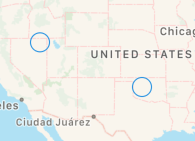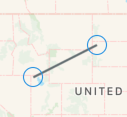MKOverlayRenderer - Drawing Lines
Today, I spent roughly 5 hours, off and on, trying to figure out why the following custom MKOverlayRenderer wasn’t rendering a line:
final class MyOverlay: NSObject, MKOverlay {
var startCoordinate: CLLocationCoordinate2D
var endCoordinate: CLLocationCoordinate2D
init(start: CLLocationCoordinate2D, end: CLLocationCoordinate2D) {
self.startCoordinate = start
self.endCoordinate = end
super.init()
}
}
final class MyOverlayRenderer: MKOverlayRenderer {
var strokeColor: Color = .clear
var lineWidth: CGFloat = 2
var myOverlay: MyOverlay { return self.overlay as! MyOverlay }
override func draw(_ mapRect: MKMapRect, zoomScale: MKZoomScale, in context: CGContext) {
guard self.startPoint != CGPoint.zero && self.endPoint != CGPoint.zero else {
return
}
context.saveGState()
let path = CGMutablePath()
path.addLines(between: [self.startPoint, self.endPoint])
context.setStrokeColor(self.strokeColor.cgColor)
context.setLineWidth(self.lineWidth)
context.addPath(path)
context.drawPath(using: .stroke)
context.restoreGState()
}
private var startPoint: CGPoint { return self.point(for: MKMapPoint(self.myOverlay.startCoordinate)) }
private var endPoint: CGPoint { return self.point(for: MKMapPoint(self.myOverlay.endCoordinate)) }
}
Which was rendering as below (circles are where the two ends of the line segments should be):

I spent hours trying to figure out why these two points weren’t rendering.
Eventually, looking through the docs, I noticed the MKRoadWidthAtZoomScale(_:) function, and wondered if I should use that as a scaling factor for my line.
So, I did that. I changed the setLineWidth line to be: context.setLineWidth(MKRoadWidthAtZoomScale(zoomScale) * max(self.lineWidth, 1)), and ran it.
Behold, it works:

But, hey, in the future. If you’re looking at MKMapView, with a custom MKOverlayRenderer, and are trying to draw line segments, remember: MULTIPLY YOUR LINE WIDTH BY MKRoadWidthAtZoomScale(_:).
For reference, the full code is below:
final class MyOverlay: NSObject, MKOverlay {
var startCoordinate: CLLocationCoordinate2D
var endCoordinate: CLLocationCoordinate2D
init(start: CLLocationCoordinate2D, end: CLLocationCoordinate2D) {
self.startCoordinate = start
self.endCoordinate = end
super.init()
}
}
final class MyOverlayRenderer: MKOverlayRenderer {
var strokeColor: Color = .clear
var lineWidth: CGFloat = 2
var myOverlay: MyOverlay { return self.overlay as! MyOverlay }
override func draw(_ mapRect: MKMapRect, zoomScale: MKZoomScale, in context: CGContext) {
guard self.startPoint != CGPoint.zero && self.endPoint != CGPoint.zero else {
return
}
context.saveGState()
let path = CGMutablePath()
path.addLines(between: [self.startPoint, self.endPoint])
context.setStrokeColor(self.strokeColor.cgColor)
let width = MKRoadWidthAtZoomScale(zoomScale) * max(1, self.lineWidth)
context.setLineWidth(width)
context.addPath(path)
context.drawPath(using: .stroke)
context.restoreGState()
}
private var startPoint: CGPoint { return self.point(for: MKMapPoint(self.myOverlay.startCoordinate)) }
private var endPoint: CGPoint { return self.point(for: MKMapPoint(self.myOverlay.endCoordinate)) }
}